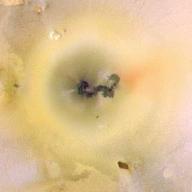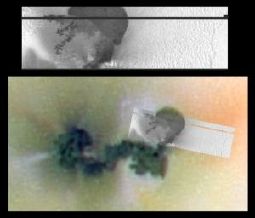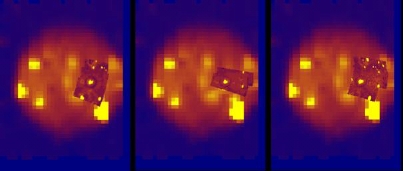Prometheus
 Known
as Io's "Old Faithful", the Prometheus volcano has been
active during every observation of it since it was first
seen by Voyager 1 in 1979. The Prometheus plume is 80 km (50
miles) tall, and although its size and shape have remained
constant over the years, its plume location has migrated
about 85 km (53 miles) to the west. Its volcanic field is
similar to those of Hawaiian volcanoes, but it is much
larger and more active. The bright, ring-shaped deposit
around the volcano forms when sulfur dioxide, ejected during
the plume eruption, condenses into snow and falls back to
the surface. Scientists have been especially interested in
determining whether the Prometheus plume is erupting from a
vent at the west end of the dark lava flow, or if it is
being produced by advancing lava as it flows over a surface
rich in sulfur dioxide. New images have helped to resolve
this question.
Known
as Io's "Old Faithful", the Prometheus volcano has been
active during every observation of it since it was first
seen by Voyager 1 in 1979. The Prometheus plume is 80 km (50
miles) tall, and although its size and shape have remained
constant over the years, its plume location has migrated
about 85 km (53 miles) to the west. Its volcanic field is
similar to those of Hawaiian volcanoes, but it is much
larger and more active. The bright, ring-shaped deposit
around the volcano forms when sulfur dioxide, ejected during
the plume eruption, condenses into snow and falls back to
the surface. Scientists have been especially interested in
determining whether the Prometheus plume is erupting from a
vent at the west end of the dark lava flow, or if it is
being produced by advancing lava as it flows over a surface
rich in sulfur dioxide. New images have helped to resolve
this question.
 A
caldera, dark lava flows, and a strange, lumpy surface
covered with sulfur-rich snow are seen in this recent image.
Originally it was thought that all of the dark material
comprised one, long lava flow. However, close examination of
this image indicates that the northeast end of the dark
material is actually a lava-filled caldera. Scientists now
believe that this caldera and hot spot are the source of the
Prometheus lava. Lava appears to be transported westward for
roughly 100 km (60 miles) through lava tubes, where it
breaks out onto a surface rich in sulfur dioxide snow. The
Prometheus plume is created by the interaction between the
hot lava and the snow. On the western rim of the caldera is
evidence that lava has spilled over the edge. This indicates
that the caldera was, at least once, completely filled with
lava. The hummocks located to the east of the Prometheus
caldera are of particular interest. One theory regarding
their formation is that they resulted from supersonic
volcanic blasts which plastered material onto preexisting
mounds on the surface.
A
caldera, dark lava flows, and a strange, lumpy surface
covered with sulfur-rich snow are seen in this recent image.
Originally it was thought that all of the dark material
comprised one, long lava flow. However, close examination of
this image indicates that the northeast end of the dark
material is actually a lava-filled caldera. Scientists now
believe that this caldera and hot spot are the source of the
Prometheus lava. Lava appears to be transported westward for
roughly 100 km (60 miles) through lava tubes, where it
breaks out onto a surface rich in sulfur dioxide snow. The
Prometheus plume is created by the interaction between the
hot lava and the snow. On the western rim of the caldera is
evidence that lava has spilled over the edge. This indicates
that the caldera was, at least once, completely filled with
lava. The hummocks located to the east of the Prometheus
caldera are of particular interest. One theory regarding
their formation is that they resulted from supersonic
volcanic blasts which plastered material onto preexisting
mounds on the surface.

The yellow areas in this infrared image are active volcanoes and lava flows, with the Prometheus volcano located in the center. Prior to obtaining this high-resolution image, only Prometheus and three other volcanoes had been observed to be active in this area. In this image, however, 14 active volcanoes have been detected.
Photo Credit: NASA/JPL
